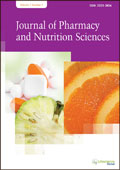jpans
|
|
Abstract: We have synthesized macromonomers by mechanochemical reaction of poly(benzyl methacrylate) (PBzMA) and maleic anhydride (MA). The ESR spectrum of the fractured sample of PBzMA and MA showed a broad singlet, which was apparently different from the spectrum of PBzMA mechanoradical. The amphiphilic blockcopolymer was synthesized with macromonomer of PBzMA and amino-terminated polyethyleneglycol (a-methyl-w-aminopropoxy polyoxyethylene, MEPA). The number average molecular weight of the produced amphiphilic blockcopolymer was 33,000. Polymeric micelles were readily prepared from the present amphiphilic blockcopolymer by a dialysis method. The mean diameter of the micelles measured by dynamic light scattering was about 146 nm. It was shown that the present macromonomer mechanically produced can be used for the synthesis of amphiphilic bockcopolymer to form polymeric micelles. Keywords: Polymeric micelle, macromonomer, maleic anhydride, mechanoradical.Download Full Article |
|
|
Abstract: Cancer cells reprogram their metabolism to meet the demands of accelerated growth. Glucose is the primary source of energy for cancer cells, but under conditions of high-energy demand lipids and free fatty acids become increasingly important. PPARγ is a member of the nuclear receptor superfamily and acts to regulate adipocyte differentiation and lipid metabolism. However, in many types of cancer, PPARγ activity is elevated in order to increase production of adipogenic factors [1, 2]. γ-Tocotrienol is an isoform of vitamin E that displays potent anticancer activity [3]. Previous studies have shown that the antiproliferative effects of combined treatment of ã-tocotrienol with PPARγ antagonists was associated with a reduction in PPARγ activity, expression of PPARγ and RXR, and suppression in Akt activation in MCF-7 and MBA-MB-231 human breast cancer cells [4]. The present study was conducted to determine the effects of combination treatment with these agents on adipogenic factor levels in rapidly proliferating human breast cancer cells. Western blot and qRT-PCR studies showed that combined treatment of γ-tocotrienol with PPARγ antagonists not only suppressed the adipogenic proteins, C/EBPβ and SREBP-1c, but also decreased their target lipogenic enzymes, ap2, FAS, and HMGCoR. However, treatment effects were also observed in PPARγ silenced breast cancer cells, indicating that these effects are mediated through PPARγ-independent mechanism. These findings suggest the combined treatment of γ-tocotrienol with PPARγ antagonist may have potential as a therapeutic strategy in the treatment of breast cancer. . Keywords: γ-Tocotrienol, PPARγ, Breast Cancer, C/EBPβ, SREBP-1c, FASN.Download Full Article |
|
|
Abstract: Grape skins and seeds are sources of phenolic compounds that contribute to the sensory characteristics and beneficial bioactivity of wines and other processed foods. Grape seed and skin extracts from foreign, wild and Iranian cultivars were assayed for their antioxidant properties and phenolic compositions. Finally, the results were compared with those of Vitis vinifera cv. Muscat of Alexandria and V.labrusca. Among the skins of grape cultivars analyzed, those of Lalsiyah contained the highest amount of total phenolics (1067.5 mg 100g-1 gallic acid equivalent of fresh weight) and antiradical activities (0.79 m mol g-1 trolox equivalent of fresh weight). In contrast, Dedeskiramfi contained highest amount of seed total phenolics (2277.3 mg 100 g-1 GAE of fresh weight). The phenolic content of different grapes depends mainly on the grape skin color. The total phenolic content of W8 and W11 with white skins was significantly different from grapes with dark skins. Lalsiyah skin contained the highest amount of total flavonoid, total anthocyanins content, total procyanidin monomers and antiradical activity. Since, total phenolic content is an index of potent antioxidant capability; Lalsiyah will be good resource of antioxidant in food and pharmaceutical industries. Keywords: Vitis, Grape skin, Grape seed, Phenol, Antiradical activity.Download Full Article |
|
|
Abstract: Background: Magnesium supplementation is of value in several different medical disorders. Several kinds of Mg-salts are commercially available. Purpose: This review evaluates their bioavailability criteria such as solubility, urinary excretion, and plasma levels of magnesium from studies of different Mg-salts. Conclusion: Although methodology differences were large, the results consistently demonstrate a better bioavailability for Mg-citrate. Keywords: Magnesium, citrate, oxide, bioavailability.Download Full Article |
|
|
Abstract: We investigated the inhibitory effect of the edible mushroom Flammulina velutipes on intracellular lipid accumulation. Among the five fractions of the F. velutipes extract, the acetone fraction had an inhibitory effect on intracellular lipid accumulation. Seven known compounds were isolated from the acetone fraction: methyl linoleate, methyl γ-linolenate, ergosterol, ergosta-5,7-dien-3b-ol, ergost-7-en-3b-ol, ergosterol peroxide, and 5,6-epoxy-24(R)-methylcholesta-7,22-dien-3b-ol. Ergosterol peroxide exhibited a potent inhibitory effect on the intracellular lipid accumulation. Our results indicate that ergosterol peroxide may be important as an anti-obesity agent since it inhibits the metabolic syndrome. Keywords: Flammulina velutipes, ergosterol peroxide, 3T3-L1 cells, lipid accumulation.Download Full Article |


